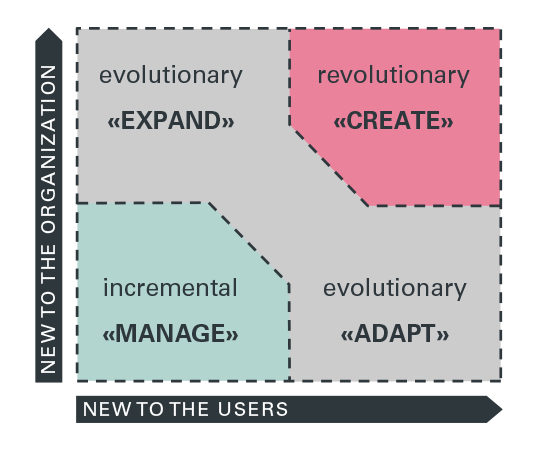INTRODUCTION TO SOCIAL INNOVATION
3.1
Examples of innovation
When people think of innovation, they usually think of technological innovation. More specifically, they think about product or service invention. But not every innovation has to be completely new to the world and it is by far not always a technological one.
From an economic perspective, innovation is the process and outcome of creating something new, which is also of value. Joseph Schumpeter, the ‘inventor’ of innovation, called it a process of creative destruction. He argued that innovation results from new combinations of assets, knowledge, people etc. This leads to new products and services, new markets, new structures and processes, or new sources of supply. While product innovation was dominating in the past, today the focus has shifted towards innovation in business models.
Especially the focus on product innovation has fueled the often existing identical understanding of innovation and invention. But a product or service can be new to a group of people, although it has existed in other contexts before. For instance, in planes, seat reservations were standard for decades. When you bought your ticket, the seat reservation was included and with the check-in you got your seat number. The low cost carriers started selling tickets without seat reservation. It made booking easier for them and they could ask for an extra charge for seat reservations. This was an innovation, but no invention, as free seating was already common in trains or buses.
Brown (2009) differentiates three types of innovation depending on the users/clients and the offers/markets. The first category asks if a service, product, or business model is new to the customers, the second asks if it is new to the company. By this, we get three different types of innovation, but four distinctive managerial contexts.

The least innovative type is incremental, offering changes for existing users in an existing offer. A bakery, for example, can offer a new type of bread based on an existing recipe to its clients by only changing the form. This innovation needs to be managed, for instance with a special marketing action.
If an innovation is either new to the company or to the customers, we speak of an evolutionary innovation type. If it is a new offer, the company has to expand its operations to new markets or new groups of customers. If our bakery develops a new vegan type of dough, it might attract new customers that prefer vegan food. If the product is new to the customers, the company needs to adapt its process. For example, the bakery rearranges its counter so that more customers at once can be served. Then it would need to explain the new process to the customers.
Finally, if the innovation is new in both ways, it is revolutionary or disruptive. There was a famous example of a bakery in New York that combined donuts and croissants to a ‘cronut’. Such a new combination is “Schumpeter at his best”. And the customers loved it!

Waiting line in front of the Dominique Ansel bakery in New York. (by David Winograd)
Often, disruptive innovations come from outside the existing industry. With the iPhone, Apple disrupted the market of mobiles without having produced any telephones before. Tesla is about to disrupt the automobile market by constructing its cars more as a computer than as a mechanical construction. By questioning and reshaping processes, structures, and resources, great changes can come from small beginnings.
The explanations so far have focused on business innovation and development – and these are often based on technological innovation. But there are also examples that entail little technological and much conceptual innovation. Just like the concept of low-cost carriers that changed the flight industry.
F. Hoffmann-La Roche, one of the biggest pharmaceutical companies, is known today for its medical innovations. However, the first innovation by Fritz Hoffmann was neither in chemistry nor pharmacy, but in production. The company was the first to offer standardized medicine. Before, pharmacists would mix the medicine every time directly for the client, which led to variations in the mixture. The standardization allowed for a constant treatment and a better dosage of the medicine.
In the following, we will take a closer look at social innovation as a concept to address new processes and structures of social challenges. The video in the next step will define the term of social innovation and explain the concepts, especially in demarcation to technological innovation.
References
Brown, T. (2009). Change by Design: How Design Thinking Transforms Organizations and Inspires Innovation. New York: Harper Business.
Lizenz
University of Basel
